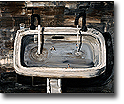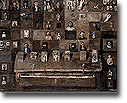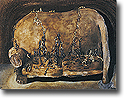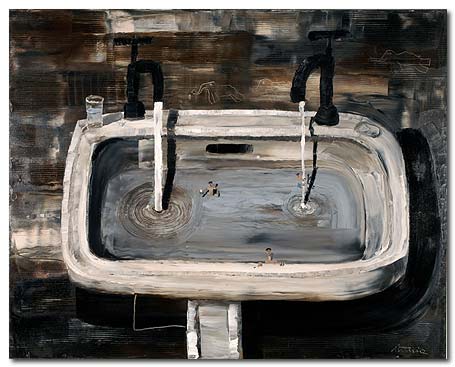Boca Raton Museum of Art,
Sep 08, 2004 - Nov 07, 2004
Boca Raton, Fl, USA
Ignacio Iturria: Everything Has A Face
by Wayne Baerwaldt
My first encounter with the work of the enigmatic and prolific painter, Iturria, was in 1996 at Plug In Gallery, the artist-run centre in Winnipeg, Canada. I had previously heard of his textured or "sculpted paintings" from the American curator Laurel Reuter. Iturria’s quirky figurative-abstract style and humanist subject matter identify him as a Latin American painter. The tragicomic conceptual landscape that informs Iturria’s magical and nostalgic canvasses is intimately linked with a region in the foothills of the Peruvian Andes. Brown, black and sepia colored paint squeezed directly onto a variety of surfaces, from stretched canvas to corrugated cardboard, give Iturria’s abstracted ’every man’ figures material mass while details in white are dramatically sculpted with a brush or spatula. The resulting three-dimensional paintings are surreal portraits of intense absurdity. Iturria imbues his Neolithic stick figures with a deliberate simplicity that lurches towards kitsch as it engages social commentary through the perverse form of cartoon sequences. Iturria’s world-view presents humanity as a house of many characters. Employing both kitsch impulse and artist’s moral rudder, Iturria’s paintings invariably reveal through their conceptual patterning a human iconography of the Americas. Quotidian rituals of everyday performance and domestic space are examined in painting after painting to weave a universal view of the human condition. Lilliputian figures inhabit segregated sparsely furnished rooms, illuminated by dangling bare light bulbs -- a simple table and chair or single bed in the foreground, it’s occupant(s) either frozen in limbo, busy with daily tasks or in the thrall of an embrace. Iturria’s innocuous apartments are human containers with expansive windows, portals to the larger world of shared human experience, symbolic of the psychic, surreal turmoil endemic to urban dwelling. As depicted through Iturria’s microscope, dwelling space is at once a shared monument to the banal modernity of contemporary living and the private hell of solitary compartments in the mental health ward ( "Stanno tutti bene", 2nd version). Iturria’s stick figures inhabit basic urban high-rise shelters, the brutal Modernist concrete architecture common to the Americas. They form something of a genealogical tree, acting as a reminder of population and social security concerns evident world-wide in the intense proliferation of jails and elimination of long-term mental health facilities. The theme of the "contained human" is one that Iturria returns to over and over. He often renders the human figure pictographically, stripped to its bare essentials, just as he strips living spaces to their essential form like cell blocks or theatre sets with a distant window or skylight or occasional barren doorway in the background. The dramatic skylight and doorway in "Apuntalar I" or "Rosario Oriental" seems just out of reach although invariably it is a dramatic relief to recognize an unexpected exit. As bleak as Iturria’s chosen settings seem to be, his wiry figures often dwell in a zany world of children’s play composed from personal childhood memories. The paintings as myriad portraits from the artist’s imagination continue to cement his strong familial bonds. He readily discusses the influence of his cultured father, an immigrant from Basque Spain whose goal was to be an artist in his adopted Uruguay, and Iturria’s mother who encouraged him to become the artist his father failed to become. Iturria paints to "honor his father’s ethics, compassion and humor." Iturria’s parents encouraged his artistic inclinations to draw and paint, to see and experience the world with an understanding of the epistemology of the Uruguayan land. His most vivid memories are of a Montevideo childhood playing with small toys on
|













